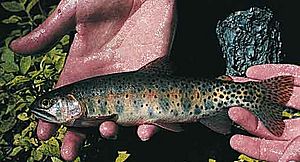Greenback cutthroat trout facts for kids
Quick facts for kids Greenback cutthroat trout |
|
|---|---|
 |
|
| Conservation status | |
| Scientific classification |
|
| Kingdom: | Animalia |
| Phylum: | Chordata |
| Class: | Actinopterygii |
| Order: | Salmoniformes |
| Family: | Salmonidae |
| Genus: | Oncorhynchus |
| Species: | |
| Subspecies: |
O. c. stomias
|
| Trinomial name | |
| Oncorhynchus clarkii stomias (Cope, 1871)
|
|
The greenback cutthroat trout (Oncorhynchus clarkii stomias) is a special type of cutthroat trout. It lives in the eastern parts of the United States. This fish was once found all over eastern Colorado and southeast Wyoming. But today, it lives in less than 1% of its original home. It is currently listed as a threatened animal. This means it needs protection to survive. The greenback cutthroat trout became the official state fish of Colorado on March 15, 1994.
Contents
What Does the Greenback Cutthroat Trout Look Like?
The greenback cutthroat trout can grow up to 18 inches (46 cm) long. It has the biggest spots of all cutthroat trout. People say it has the brightest colors when it is ready to spawn (lay eggs). Like all cutthroat trout, it has red marks near its lower jaw and throat. In the past, some of these fish were reported to weigh as much as 4.5 kilograms (9.9 lb)!
Where Do Greenback Cutthroat Trout Live?
Scientists believe the cutthroat trout developed over the last two million years. They came from other Oncorhynchus fish species. These fish moved up the Columbia and Snake river basins. Then they reached the Green and Yellowstone river basins. About 20,000 years ago, during the last ice age, some fish crossed the Continental Divide. This group eventually became the greenback cutthroat trout.
Today, the greenback cutthroat trout lives east of the Continental Divide. You can find them in the cold, clear waters of the Arkansas River and South Platte River. These rivers are in the foothills and mountains. In the late 1800s, these fish were very common. They lived along the Front Range from Wyoming to New Mexico. But their numbers started to drop when settlers arrived.
Why Did Their Numbers Decline?
Many things caused the greenback cutthroat trout to decline.
- Mining in their river homes led to dirt and harmful chemicals in the water.
- People took water from rivers for farming. This left less water for the fish.
- Too much overfishing also hurt their populations.
New types of fish were also brought into their homes. These included brook trout (Salvelinus fontinalis), brown trout (Salmo trutta), and rainbow trout (O. mykiss).
- Brook trout and brown trout competed with the greenback cutthroat for food and space.
- Rainbow trout sometimes bred with greenback cutthroat trout. This created mixed fish called "cutbows."
- Other types of cutthroat trout were also put into greenback habitats. This caused more mixing and hurt the pure greenback populations.
Working to Save the Greenback Cutthroat Trout
For a long time, people thought the greenback cutthroat trout was gone forever. By the 1930s, it was believed to be extinct. But in 1957, a group of these fish was found! They were in Rocky Mountain National Park, in the Big Thompson River. This river flows into the South Platte. More fish were found in 1965 and 1970. Because of these discoveries, the fish was listed as endangered in 1973.
Groups like the U.S. Fish and Wildlife Service and Trout Unlimited are working hard to help the greenback cutthroat trout. Their efforts helped change the fish's status from endangered to threatened. This means they are still in danger but doing a bit better. The Bozeman National Fish Hatchery played a big role in helping these fish recover.
In 2012, scientists did a DNA study. They compared DNA from modern fish and old samples from the 1800s. This study showed that the only pure greenback cutthroat trout left live in a 4-mile (6.4 km) stretch of Bear Creek. This creek flows into the Arkansas River. Many fish that people thought were greenbacks were actually other types, like the Colorado River cutthroat trout or Rio Grande cutthroat trout.
Today, you can fish for greenback cutthroat trout in some areas. But you must practice Catch and release fishing. This means you catch the fish and then carefully let it go. This helps protect their populations.


